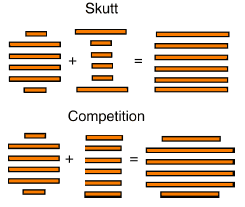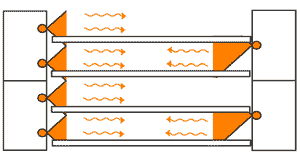Computer Balanced Elements
Balanced Elements and Zone Control

Nearly all Skutt kilns have Computer Balanced Elements. This means we design the elements so that more heat is put in areas of the kiln that naturally fire cooler. The top and bottom of the kiln lose heat faster than the center so Skutt puts hotter elements (more power) in those areas.
The figures to the right indicate how a kiln with Balanced Elements will take a naturally unbalanced chamber and adjust it to be balanced.
This also has an impact on the efficiency and capability of Zone Control. By balancing the heat in the chamber to start, Zone Control does not have to work as hard. You have less cycling (zones turning on and off to balance the heat) and when the kiln does need to cycle the power, it is distributed efficiently into the areas that need it the most.
The bottom line is money saved on electricity, tighter controls, and faster turn around times.
2 Element Grooves Per Brick

It is always recommended to have an element between each shelf. This is because the radiant heat from the elements needs a clear path to heat up the ware in the chambers that are formed between each shelf.
It is much easier to load a kiln with 2 element grooves per brick because you have so many more options for shelf placement. The figure to the right indicates how you could get in
trouble with a 1 element groove per brick design.
If there is not an element between the shelves, the heat must soak through the shelves to heat those chambers. Since the effect of this is more dramatic at lower temperatures this could be disastrous when candling or going through quartz inversion.
The effect is compounded even further when the thermocouple is located in an area that is blocked. When the thermocouple is in this position it will read cooler than the other sections and therefore the sections with an element radiating into them will get significantly hotter.
More Than Just Ohms
There are many aspects of element design that affect the performance and life of the element. The watt density, pitch, and gauge must be perfectly balanced to achieve the best results.
One limiting factor to element design can be having enough room to put the proper amount and gauge of wire. That is one of the reasons why Skutt makes sure each brick has 2 element grooves. More grooves give you more design options and fewer concessions need to be made.
Most manufacturers try to use the heaviest gauge of element wire possible to increase element life. The thicker the wire the cooler it will run therefore you need to use more of it to get enough power in the kiln to heat it to temperature. With only 1 element groove per brick you cannot always do this and you are forced to use a lighter gauge wire. Just because a company says they have “Heavy Duty Elements” doesn’t mean that they are actually using heavy gauge elements.

